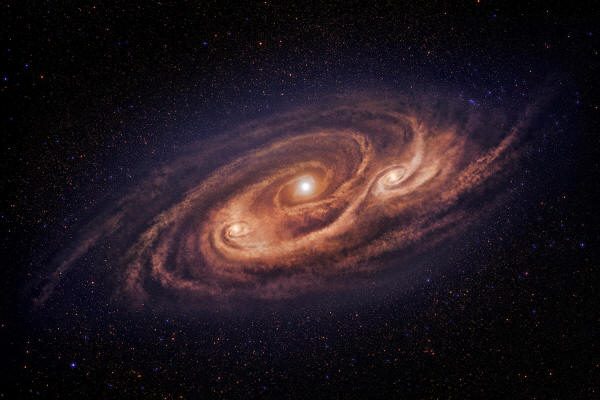|

by Sarah Lewin
August 29,
2018
from
Space Website

An artist's impression of
the
ancient, huge galaxy COSMOS-AzTEC-1,
which
researchers have found has
three
dense, star-forming regions.
The
galaxy can be seen forming stars
at an
extremely fast rate.
Credit: National Astonomical Observatory of Japan
Some 12.4 billion light-years from Earth, a monster galaxy can be
seen forming stars 1,000 times faster than the Milky Way does.
It's
less of a mess than researchers expected - but its frenetic pace
can't last.
Researchers using the Atacama Large Millimeter/submillimeter Array
(ALMA) observatory in Chile have gotten the closest look ever at the
galaxy, called COSMOS-AzTEC-1:
So-called extreme
starburst galaxies may be the predecessors of modern galaxies like
the Milky Way, and so understanding them lends insight into how
today's galaxies formed and evolved.
Researchers knew the galaxy was rich in star-forming gas when they
first spotted it 10 years ago, but the details of the gassy giant
revealed with ALMA weren't what they expected.
"A real surprise is
that this galaxy seen almost 13 billion years ago has a massive,
ordered gas disk that is in regular rotation instead of what we
had expected, which would have been some kind of a disordered
train wreck that most theoretical studies had predicted," Min
Yun, an astronomer at University of Massachusetts, Amherst, and
co-author on the new work,
said in a statement.
The ancient galaxy's
structure held other surprises, as well.
With ALMA, they saw that
instead of just one dense cloud of material in the center, there
were two extra blobs of star-generating gas.
"We found that there
are two distinct large clouds several thousand light-years away
from the center," Ken-ichi Tadaki, the study's lead author and a
researcher at the Japan Society for the Promotion of Science and
Japan's National Astronomical Observatory, said in the
statement.
"In most distant
starburst galaxies, stars are actively formed in the center. So
it is surprising to find off-center clouds."
And its off-the-charts
star formation (below video) comes from an inherent instability, the
researchers said:
In most galaxies, clouds
of gas collapse and form stars, which eventually explode into
supernovas, pushing gas outward again and slowing the pace of star
birth.
But in this galaxy, gravity is winning:
More and more gas is
collapsing into stars, without being pushed outward strongly enough
to slow down.
Researchers have been wondering for a long time how early galaxies
could form stars so quickly, the researchers said.
"How these galaxies
have been able to amass such a large quantity of gas in the
first place and then essentially turn the entire gas reserve
into stars in the blink of an eye, cosmologically speaking, was
a completely unknown question about which we could only
speculate," Yun said.
"We have the first
answers now."

The Atacama Large Millimeter/submillimeter
Array (ALMA) observatory in Chile
provided these new views
of the monster galaxy COSMOS-AzTEC-1.
On
the left, you can see the distribution of molecular gas,
and on the right, you can see the distribution of dust.
Those high-density zones are the key areas
for the galaxy's rapid star formation.
Credit: Tadaki et al./ALMA (ESO/NAOJ/NRAO)
If the early universe were populated with galaxies with structures
like this one, they could have accumulated huge amounts of gas
before suddenly blasting out stars in a runaway effect - although
the researchers still don't know how the galaxy was able to build up
gas in so stable a fashion before the reaction began.
And the ancient galaxy's life is likely fleeting:
The researchers said
it will be completely consumed in 100 million years, 10 times
faster than other star-forming galaxies.
The researchers speculate
that colliding galaxies could have merged to create the behemoth but
would need more research - and to look at more ancient galaxies in
this much detail - to evaluate how likely that origin is, and to
learn more about our mammoth galactic predecessors.
The new work (The
Gravitationally Unstable Gas Disk of a Starburst Galaxy 12 Billion
Years Ago) was detailed today (Aug. 29) in the journal
Nature.
|



